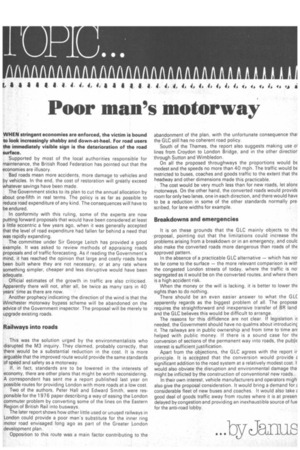Poor man's motorway
Page 64

If you've noticed an error in this article please click here to report it so we can fix it.
WHEN stringent economies are enforced, the victim is bound to look increasingly shabby and down-at-heel. For road users the immediately visible sign is the deterioration of the road surface.
Supported by most of the local authorities responsible for maintenance, the British Road Federation has pointed out that the economies are illusory.
Bad roads mean more accidents, more damage to vehicles and by vehicles. In the end, the cost of restoration will greatly exceed whatever savings have been made.
The Government sticks to its plan to cut the annual allocation by about one-fifth in real terms. The policy is as far as possible to reduce road expenditure of any kind. The consequences will have to be endured.
In conformity with this ruling, some of the experts are now putting forward proposals that would have been considered at least a little eccentric a few years ago, when it was generally accepted that the level of road expenditure had fallen far behind a need that was rapidly expanding.
The committee under Sir George Leitch has provided a good example. It was asked to review methods of appraising roads proposals and of traffic forecasting. As if reading the Government's mind, it has reached the opinion that large and costly roads have been built where they are not necessary, or at any rate where something simpler, cheaper and less disruptive would have been adequate.
Official estimates of the growth in traffic are also criticised. Apparently there will not, after all, be twice as many cars in 40 years' time as there are now.
Another prophecy indicating the direction of the wind is that the Winchester motorway bypass scheme will be abandoned on the advice of the Government inspector. The proposal will be merely to upgrade existing roads.
Railways into roads
This was the solution urged by the environmentalists who disrupted the M3 inquiry. They claimed, probably correctly, that there would be a substantial reduction in the cost. It is more arguable that the improved route would provide the same standards of speed and safety as a motorway.
If, in fact, standards are to be lowered in the interests of economy, there are other plans that might be worth reconsidering. A correspondent has sent me a report published last year on possible routes for providing London with more roads at a low cost.
Two of the authors, Peter Hall and Edward Smith, were responsible for the 1976 paper describing a way of easing the London commuter problem by converting some of the lines on the Eastern Region of British Rail into busways.
The later report shows how other little used or unused railways in London could provide a poor man's substitute for the inner ring motor road envisaged long ago as part of the Greater London development plan.
Opposition to this route was a main factor contributing to the abandonment of the plan, with the unfortunate consequence thai the GLC still has no coherent road policy.
South of the Thames, the report also suggests making use ol lines from Croydon to London Bridge, and in the other directior through Sutton and Wimbledon.
On all the proposed throughways the proportions would bE modest and the speeds no more than 40 mph. The traffic would bE restricted to buses, coaches and goods traffic to the extent that thE headway and other dimensions made this practicable.
The cost would be very much less than for new roads, let alonE motorways. On the other hand, the converted roads would providE room for only two lanes, one in each direction, and there would haw to be a reduction in some of the other standards normally pre, scribed, for lane widths for example.
Breakdowns and emergencies
It is on these grounds that the GLC mainly objects to thE proposal, pointing out that the limitations could increase thE problems arising from a breakdown or in an emergency, and coulc also make the converted roads more dangerous than roads of thE approved pattern.
In the absence of a practicable GLC alternative — which has no so far come to the surface — the more relevant comparison is with the congested London streets of today, where the traffic is no segregated as it would be on the converted routes, and where therE is a high accident risk.
VVhen the money or the will is lacking, it is better to lower thE sights than to do nothing.
There should be an even easier answer to what the GLC apparently regards as the biggest problem of all. The proposa requires the straightforward and inexpensive transfer of BR land and the GLC believes this would be difficult to arrange.
The reasons for this diffidence are not clear_ If legislation needed, the Government should have no qualms about introducinc it. The railways are in public ownership and from time to time arE helped with public money. If there is a sound case for thE conversion of sections of the permanent way into roads, the pubji( interest is sufficient justification.
Apart from the objections, the GLC agrees with the report ir principle. It is accepted that the conversion would provide significant addition to the road system at a relatively modest cost. I would also obviate the disruption and environmental damage tha might be inflicted by the construction of conventional new roads.
In their own interest, vehicle manufacturers and operators migh also give the proposal consideration. It would bring a demand for considerable fleet of new buses and coaches. It would also take E good deal of goods traffic away from routes where it is at presen delayed by congestion and providipg an inexhaustible source of fue for the anti-road lobby.
















































































































